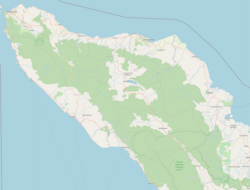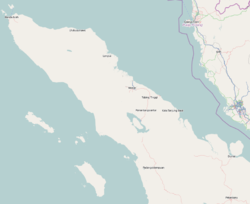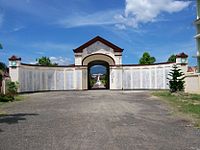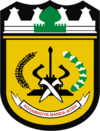Banda Aceh
Banda Aceh | ||
|---|---|---|
City | ||
| City of Banda Aceh Kota Banda Aceh | ||
| Other transcription(s) | ||
| • Jawoë | باندا اچيه | |
      From top left : Baiturrahman Grand Mosque, Aceh Tsunami Museum, Seulawah 001 Monument, 2004 Indian Ocean Tsunami Monument, Gunongan Historical Park, Kerkhof Peucut | ||
| ||
| Nickname(s): Kota Serambi Mekkah | ||
| Motto(s): Saboeh Pakat Tabangun Banda | ||
 Location within Aceh | ||
 Banda Aceh Location in Aceh, Northern Sumatra, Sumatra and Indonesia Show map of Aceh  Banda Aceh Banda Aceh (Northern Sumatra) Show map of Northern Sumatra  Banda Aceh Banda Aceh (Sumatra) Show map of Sumatra  Banda Aceh Banda Aceh (Indonesia) Show map of Indonesia | ||
| Coordinates: 5°33′0″N 95°19′0″E / 5.55000°N 95.31667°E / 5.55000; 95.31667Coordinates: 5°33′0″N 95°19′0″E / 5.55000°N 95.31667°E / 5.55000; 95.31667ID | ||
| Country | ||
| Province | ||
| Founded | 22 April 1205 | |
| Government | ||
| • Mayor | Aminullah Usman | |
| • Vice Mayor | Zainal Arifin | |
| Area | ||
| • City | 61.36 km2 (23.69 sq mi) | |
| • Metro | 2,935,36 km2 (113,335 sq mi) | |
| Elevation | 0–10 m (0–32.9 ft) | |
| Population (2016)[1] | ||
| • City | 356,983 | |
| • Density | 5,800/km2 (15,000/sq mi) | |
| • Metro | 513,698 | |
| • Metro density | 1.8/km2 (4.5/sq mi) | |
| Demonyms | Acehnese Warga Aceh (id) Kawom Aceh (ace) | |
| Demographics | ||
| • Ethnic groups | Acehnese | |
| • Religion | Islam 97.09% Buddhism 1.13% Christianity 0.70% Catholic 0.19% Hinduism 0.02% Others 0.85% [2] | |
| • Languages | Indonesian (official) Acehnese (regional) | |
| Time zone | UTC+7 (Indonesia Western Time) | |
| Postal code | 23000 | |
| Area code | (+62) 651 | |
| Vehicle registration | BL XXX XX | |
| Website | www.bandaacehkota.go.id | |
Banda Aceh is the capital and largest city in the province of Aceh, Indonesia. It is located on the island of Sumatra and has an elevation of 35 meters. The city covers an area of 64 square kilometres and had a population of 219,070 people, according to the 2000 census.[3] Banda Aceh is located on the northwestern tip of Indonesia at the mouth of the Aceh River.
The city was originally established as Bandar Aceh Darussalam Kandang[4] and served as a capital and hub for the Sultanate of Aceh upon its foundation in the late 15th century. Later its name was changed to Bandar Aceh Darussalam, and then became popularly known as Banda Aceh. The first part of the name comes from the Persian bandar (بندر) meaning "port" or "haven." The city is also dubbed the "port to Mecca," or the "porch of Mecca" (Indonesian: Serambi Mekkah) in reference to the days when hajj pilgrims travelled by sea from Indonesia and would make a stop over in the city before continuing their journey to Mecca.
Banda Aceh had long been at the centre of protracted conflicts between the Acehnese and foreign domination, including war with Portuguese, wars with the Dutch, the Japanese and the Indonesian government. The city rose to international prominence in the aftermath of the Indian Ocean earthquake in 2004, which struck off the western coast of Sumatra. Banda Aceh was the closest major city to the earthquake's epicentre, which lay 249 km off the coast.[5] It suffered great damage in the earthquake and further damage when a tsunami struck shortly afterwards. 167,000 people died as a result and many more were injured.[6][7]
The aftermath of the tsunami has seen a cessation of much of the conflict in the city and province, and domestic and international aid as a result has seen a major modernisation and reconstruction of the city over the past decade.[8]
Contents
1 History
2 Administrative divisions
3 Transportation
4 Media
5 Sport
5.1 Sport Complex
5.2 Indoor Sport Hall
5.3 Football
6 Climate
7 Tourism
8 Religion
9 Sister cities
10 References
11 Bibliography
12 External links
History
Banda Aceh, situated at the tip of Sumatra, has long been a strategic, transportation and trading hub in the eastern Indian Ocean. Its first mention in western accounts comes from 1292 when Marco Polo and his expedition visited the city, referred to as 'Lambri' from Lamuri Kingdom which previously existed there and noted as the logical first port of call for travelers from Arabia and India to Indonesia.[9]Ibn Battuta also reported visiting the city in the mid-14th century when under the control of the trading kingdom of Samudera Pasai, the then dominant entity in northern Sumatra.[10] However the Pasai began to collapse under pressure from declining economic conditions and the Portuguese, who occupied much of the area after occupying Malacca in the early 15th century. Sultan Ali Mughayat Syah, ruler of the newly founded Sultanate of Aceh, aggressively expanded in the area in the 1520s and established sultanate was built on the remains of the Pasai and other extinct kingdoms in the area, and made Banda Aceh the capital, naming it for himself as Kutaraja or 'City of the King'.

Koetaradja/Banda Aceh old map
After a long period of rule by the Sultanate, Aceh began to come into conflict with the Dutch and the British in the second half of the 18th century. At the end of the 18th century, the territory of Aceh in the Malay Peninsula, namely Kedah and Pulau Pinang, were seized by the British. In 1871, the Dutch began to threaten Aceh, and on 26 March 1873, the Dutch formally declared war on Aceh. The Dutch bombarded the capital in that year and sought to capture the Sultan's palace in the city to bring about a capitulation of the Acehnese. Significant support from the British in the region led the modernisation and fortification of the city, and while coastal areas were lost the Dutch underestimated the city's defences. The Dutch expedition commander General Johan Köhler was killed in a skirmish around the city, leading to the failure of the first expedition. A second expedition was mounted by the Dutch within months and was successful in overwhelming the city. The Dutch moved into the capital in January 1874 believing the Acehnese to have surrendered; however, the conflict moved into the countryside, and the Acehnese continued to actively oppose Dutch rule.

Banda Aceh aerial view after tsunami disaster, 2004
After it entered the Government of the Republic of Indonesia on 28 December 1962, the name of the city was changed back to Banda Aceh by the Ministry of Public Administration and Regional Autonomy on 9 May 1963. On 26 December 2004, the city was hit by a tsunami caused by the 9.2-magnitude earthquake in the Indian Ocean. The disaster killed 167,000 inhabitants and destroyed more than 60% of the city's buildings. Based on the statistical data issued by the City Government of Banda Aceh, Banda Aceh had 248,727 inhabitants in May 2012.[citation needed]
Administrative divisions

Mayor office of Banda Aceh
Banda Aceh is divided into nine subdistricts (Indonesian: kecamatan):
- Baiturrahman
- Banda Raya
- Jaya Baru
- Kuta Alam
- Kuta Raja
- Lueng Bata
- Meuraksa
- Syiah Kuala
- Ulee Kareng
Transportation
Motorised becaks are common in Banda Aceh. Transport by taxis and minibuses, known as labi-labi, are also common.
Sultan Iskandar Muda International Airport is located in Blang Bintang, 13.5 km from Banda Aceh.
Two main highways run from Banda Aceh to the south. One runs down the eastern side of the province through main towns such as Bireuen and Lhokseumawe to Medan, the large capital of the province of North Sumatra. The other highway runs down the western side of the province, through lesser-populated areas, to the towns of Calang, Meulaboh, and Singkil. The main bus station, Terminal Terpadu Batoh, is located at Jalan Mr. Teuku Muhammad Hasan.
Banda Aceh has two sea ports, Pelabuhan (port) Ulèë Lheuë and Pelabuhan Malahayati.[11] Pelabuhan Ulèë Lheuë was formerly the main sea port in Aceh. It now functions as a ferry terminal. It is located in the Meuraksa area. Pelabuhan Malahayati, the current main sea port, is located in Krueng Raya, 27 km from Banda Aceh. It now functions as the main freight cargo terminal.
Since May 2016, Banda Aceh has had a bus rapid transit system, called Trans Koetaradja. Initially, Trans Koetaradja runs only a single line Keudah - Darussalam (vv) (Corridor I), which operates from 06.30-18.36 on Monday-Saturday and 07.20-17.20 on Sunday and Holidays.[12] Since 2017, it added 2 additional lines: Corridor II-A with route Sultan Iskandar Muda International Airport - Pasar Aceh (vv) and operates from 08.00-18.20 everyday;[13] and Corridor II-B with route Pelabuhan Ulèë Lheuë (Port) - Pasar Aceh (vv) and operates from 07.00-18.35 everyday.[14] From 2016 till 2018, thanks to subsidies from Aceh government, it is a free-of-charge transportation for passengers.[15]
Media

Banda Aceh at night
The TVRI Aceh, state-owned, Kutaraja TV and Aceh TV, both privately owned, are the local TV stations in Banda Aceh. The oldest newspaper in the Banda Aceh region is Harian Serambi Indonesia. Several other newspapers such as Harian Aceh, Harian Waspada, Harian ProHaba, and Harian RajaPost are also available.
Sport
Sport Complex
Lapangan Blang Padang is a multi-use park located in the centre of Banda Aceh, and has become location for citizen sport activities for decades. It has jogging track, volleyball court, football pitch, basketball court and foodcourts, as well.[16] There is a famous replica of RI 001, the first Indonesian plane, at Lapangan Blang Padang.
Some other sport complexes in Banda Aceh are: Lapangan Neusu, Komplek Harapan Bangsa, Lapangan Gelanggang Unsyiah and Lapangan Tugu[17]
Indoor Sport Hall
In Banda Aceh, there are several indoor sport halls (id: Gelanggang Olah Raga, abbreviated as GOR) which previously hosted as venue for multiple sports: GOR KONI, GOR Dista, GOR Pango and GOR A. Madjid Ibrahim Unsyiah.
Football
The city has two major football stadiums:
Harapan Bangsa Stadium (seating capacity: 45,000), which is the homeground of Aceh United F.C.
H. Dimurthala Stadium (seating capacity: 20,000), which is the homeground of Persiraja Banda Aceh and Kuala Nanggroe F.C.
In addition, there are also several small capacity stadiums in the city, i.e.: Syiah Kuala University Stadium and Lambhuk Mini Stadium.
Climate
Banda Aceh features a tropical rainforest climate under the Köppen climate classification, with near constant average temperatures. The city's annual average temperature is 27 degrees Celsius. However, the city features wetter and drier seasons, with June through August being the driest months of the year. Like all cities with a tropical rainforest climate, Banda Aceh does not have a true dry season month where an average of less than 60 mm of precipitation falls. On average, the city experiences a little less than 2000 mm of precipitation annually.
| Climate data for Banda Aceh | |||||||||||||
|---|---|---|---|---|---|---|---|---|---|---|---|---|---|
| Month | Jan | Feb | Mar | Apr | May | Jun | Jul | Aug | Sep | Oct | Nov | Dec | Year |
| Daily mean °C (°F) | 27.01 (80.62) | 26.88 (80.38) | 27.02 (80.64) | 27.30 (81.14) | 27.89 (82.2) | 27.99 (82.38) | 27.76 (81.97) | 27.76 (81.97) | 27.12 (80.82) | 26.72 (80.1) | 26.54 (79.77) | 26.86 (80.35) | 27.24 (81.03) |
| Average precipitation mm (inches) | 256 (10.08) | 114 (4.49) | 117 (4.61) | 139 (5.47) | 143 (5.63) | 84 (3.31) | 95 (3.74) | 90 (3.54) | 161 (6.34) | 200 (7.87) | 225 (8.86) | 321 (12.64) | 1,945 (76.57) |
| Average rainy days | 8.5 | 5.9 | 7.8 | 8.8 | 12.4 | 10.3 | 9.2 | 10.6 | 12.5 | 15.5 | 14.3 | 12.7 | 128.5 |
| Source: [18] | |||||||||||||
Tourism
As the capital of the Aceh province, Banda Aceh is home to many landmarks important to the history of the Acehnese people and the sultanates.

Baiturrahman Grand Mosque

Gunongan

Kerkhoff Poucut entry gate

Aceh Museum
- The Baiturrahman Grand Mosque, located in the heart of Banda Aceh, is the most famous landmark in the city. The original mosque was built during the Sultanate of Iskandar Muda (1607–1636). It was rebuilt in 1875 after it was burnt down in the Aceh war. The architecture and interior design of the mosque is notable for having seven domes and four smaller towers along with a main tower. The mosque can accommodate up to 9,000 people.
Gunongan Historical Park is a private playground and bathing place, built by Sultan Iskandar Muda, dedicated to his wife Putroe Phang. Gunongan was part of royal garden complex Taman Sari.[19]- A number of places near the centre of Banda Aceh have been established as reminders of, and to provide information about, the impact of the 2004 Indian Ocean earthquake and tsunami on the city. These include several mass burial centres such as the graves at Ulee Lheue, places where boats were carried several kilometres inland by the tsunami (PLTD Apung 1, or the "Floating Diesel Plant", and the "Floating Boat on the Roof"), and the Tsunami Museum. The PLTD Apung 1 had been located near the Ule Lheu beach before being shifted close to the city centre by the tsunami. It has become one of the most important landmarks in Banda Aceh.
Dutch Kerkhof Poucut Cemetery is a Dutch military burial ground located near the centre of Banda Aceh, next to the tsunami museum. The cemetery name is a combination of Kerkhof (Dutch for churchyard or graveyard) and poucut or poteu cut (Acehnese for prince). The Kerkhoff Poucut is recorded as the largest Dutch military cemetery outside the Netherlands. There are around 2,200 graves of white Dutch soldiers as well as recruits from Ambon, Manado and Java, and several Dutch generals.[20]- The Aceh Museum is one of the oldest museums in Indonesia. The original museum was established almost 100 years ago. After Independence in 1945 the museum became the property of the regional government. In 1969 the museum was moved from the original site at Blang Padang to the current location in Jl Sultan Alaiddin Mahmudsyah. The museum contains a wide range of artefacts relating to the history and cultural life of Aceh.
- Cut Nyak Dien Museum. The museum is a replica of Aceh's hero, Tjut Nyak Dien. was a leader of the Acehnese guerrilla forces during the Aceh War. Following the death of her husband Teuku Umar, she led guerrilla actions against the Dutch for 25 years. She was posthumously awarded the title of National Hero of Indonesia on May 2, 1964 by the Indonesian government.
Besides its landmarks, royal heritage sites, and attractive beaches, Banda Aceh is also famous for its keudè kupi (coffee shop) where specially brewed coffee is served. There are two kind of brewed coffees Ulèë Karéng and Beurawé coffee.[21][22]
Several festivals are held annually by the city:[23]
- Banda Aceh Festival
- Festival Krueng Aceh Peunayong
- Festival Geulayang Tunang (kite festival)
- Festival Kupi
- Indonesia City Expo
There are three beaches close to Banda Aceh which can be visited by car or motorcycle in 15 to 20 minutes:[24]
- Ujông Batèë Beach, a black sand beach with calm waves, suitable for swimming and kids' activities
- Lhôk Nga Beach, dangerous for swimming
- Lam Pu'uk Beach, very quiet, the most developed beach, visited by local and foreign tourists, suitable for surfing and watching the sunset; has cliffs and good scenery
Religion
The religion of the majority of the population is Islam, with minorities including Buddhists, Christians (both Protestant and Catholic), and Hindus.
Banda Aceh is home to four long-standing churches: the Hati Kudus Catholic church, Western Indonesian Protestant church (GPIB), Methodist church, and the Batak Protestant church (HKBP). There are 93 mosques and 112 musholla (small mosques). There is a Buddhist temple and a Hindu temple in the city.[25]
The Hindu community consists of both Balinese Hindus and Tamil Hindus who originate from India.[26]
Sister cities
 Samarkand, Uzbekistan[27]
Samarkand, Uzbekistan[27] Apeldoorn, Netherlands[28][29]
Apeldoorn, Netherlands[28][29] Sana'a, Yemen
Sana'a, Yemen Martapura, South Kalimantan
Martapura, South Kalimantan
References
^ http://www.depkes.go.id/downloads/Penduduk%20Kab%20Kota%20Umur%20Tunggal%202014.pdf Estimasi Penduduk Menurut Umur Tunggal Dan Jenis Kelamin 2014 Kementerian Kesehatan
^ Data Sensus Penduduk 2010 - Badan Pusat Statistik Republik Indonesia <http://sp2010.bps.go.id/index.php/site/tabel?tid=321&wid=8100000000>
^ Seta, William J. Atlas Lengkap Indonesia dan Dunia (untuk SD, SMP, SMU, dan Umum). Pustaka Widyatama. p. 7. ISBN 979-610-232-3..mw-parser-output cite.citationfont-style:inherit.mw-parser-output qquotes:"""""""'""'".mw-parser-output code.cs1-codecolor:inherit;background:inherit;border:inherit;padding:inherit.mw-parser-output .cs1-lock-free abackground:url("//upload.wikimedia.org/wikipedia/commons/thumb/6/65/Lock-green.svg/9px-Lock-green.svg.png")no-repeat;background-position:right .1em center.mw-parser-output .cs1-lock-limited a,.mw-parser-output .cs1-lock-registration abackground:url("//upload.wikimedia.org/wikipedia/commons/thumb/d/d6/Lock-gray-alt-2.svg/9px-Lock-gray-alt-2.svg.png")no-repeat;background-position:right .1em center.mw-parser-output .cs1-lock-subscription abackground:url("//upload.wikimedia.org/wikipedia/commons/thumb/a/aa/Lock-red-alt-2.svg/9px-Lock-red-alt-2.svg.png")no-repeat;background-position:right .1em center.mw-parser-output .cs1-subscription,.mw-parser-output .cs1-registrationcolor:#555.mw-parser-output .cs1-subscription span,.mw-parser-output .cs1-registration spanborder-bottom:1px dotted;cursor:help.mw-parser-output .cs1-hidden-errordisplay:none;font-size:100%.mw-parser-output .cs1-visible-errorfont-size:100%.mw-parser-output .cs1-subscription,.mw-parser-output .cs1-registration,.mw-parser-output .cs1-formatfont-size:95%.mw-parser-output .cs1-kern-left,.mw-parser-output .cs1-kern-wl-leftpadding-left:0.2em.mw-parser-output .cs1-kern-right,.mw-parser-output .cs1-kern-wl-rightpadding-right:0.2em
^ Harun, Ramli; M.A. Gani, Tjut Rahma (1985). Adat Aceh. Jakarta: Departemen Pendidikan dan Kebudayaan. p. 24.
^ John Pike, 'Banda Aceh', accessed 23 January 2011.
^ Jayasuriya, Sisira and Peter McCawley in collaboration with Bhanupong Nidhiprabha, Budy P. Resosudarmo and Dushni Weerakoon, The Asian Tsunami: Aid and Reconstruction after a Disaster, Cheltenham UK and Northampton MA USA: Edward Elgar and Asian Development Bank Institute, 2010.
^ Jayasuriya and McCawley, ibid.
^ Lamb, Katie (27 January 2014). "Banda Aceh: where community spirit has gone but peace has lasted". The Guardian. Retrieved 6 February 2015.
^ Polo, Marco (2010). The Book of Ser Marco Polo, the Venetian. Cambridge, UK: Cambridge University Press. p. 243. ISBN 978-1-108-02207-1.
^ Feener, R. Michael (2011). Mapping the Acehnese Past. Leiden, NL: KITLV Press. p. 43. ISBN 978-90-6718-365-9.
^ "Pelabuhan". Bandaacehkota.go.id. Retrieved 9 December 2013.
^ "Jadwal Trans Koetaradja Koridor I (Keudah - Darussalam)". acehprov.go.id. Retrieved 2 June 2018.
^ "Jadwal Trans Koetaradja Koridor II-A (Blang Bintang - Pasar Aceh)". acehprov.go.id. Retrieved 2 June 2018.
^ "Jadwal Trans Koetaradja Koridor II-B (Pelabuhan Ulee Lheue - Pasar Aceh)". acehprov.go.id. Retrieved 2 June 2018.
^ "2018 Trans K Layani 4 Koridor". aceh.tribunnews.com. Retrieved 6 June 2018.
^ "Lima Aktivitas Rekomended di Blang Padang". www.bandaacehtourism.com (in Indonesia). Retrieved 6 June 2018.CS1 maint: Unrecognized language (link)
^ "6 Lokasi untuk Berolahraga di Kota Banda Aceh". helloacehku.com (in Indonesia). Retrieved 6 June 2018.CS1 maint: Unrecognized language (link)
^ "Banda Aceh, Indonesia – Solar energy and surface meteorology". Gaisma.com. August 2011. Retrieved 9 December 2013.
^ "Gunongan". Bandaacehtourism.com. Archived from the original on 8 February 2012. Retrieved 9 December 2013.
^ Hotli Semanjuntak, 'Kerkhoff Poucut Cemetery, testifying to the Aceh War', The Jakarta Post, 20 March 2012.
^ "Coffee Shopping". Aceh-hotels.com. Archived from the original on 29 May 2013. Retrieved 9 December 2013.
^ "Cafe in Aceh". Lonelyplanet.com. Retrieved 9 December 2013.
^ "Festival". Bandaacehtourism.com. Archived from the original on 8 February 2012. Retrieved 9 December 2013.
^ "Menikmati hembusan keindahan pantai Aceh". Waspada.co.id. 27 March 2011. Retrieved 9 December 2013.
^ "Banda Aceh to act quickly to prevent religious conflicts". The Jakarta Post. 19 December 2012. Retrieved 8 July 2013.
^ "Google Translate". Translate.google.co.uk. 22 March 2012. Retrieved 8 July 2013.
^ "Banda Aceh – Samarkand". Kbri-tashkent.go.id. Retrieved 9 December 2013.
^ "Dutch – Indonesian sister cities". Id.indonesia.nl. Archived from the original on 14 December 2013. Retrieved 9 December 2013.
^ "Sister Cities". Kompetiblog2011.studidibelanda.com. Archived from the original on 10 July 2012. Retrieved 9 December 2013.
Bibliography
- Dallal, Tamalyn. 40 Days & 1001 Nights: One Woman's Dance Through Life in the Islamic World..., 2007.
ISBN 0-9795155-0-5 (book). The first part of the journey through the Islamic world goes through Banda Aceh and describes everyday life of the people in this part of Indonesia.
External links
| Wikimedia Commons has media related to Banda Aceh. |
 Banda Aceh travel guide from Wikivoyage
Banda Aceh travel guide from Wikivoyage- Official site
- Banda Aceh Tourism Official site
- Aceh.net Visit Aceh: Eco and Islamic Tourism, Cultural Information, Investment and highlights of directory
- Video: Banda Aceh


